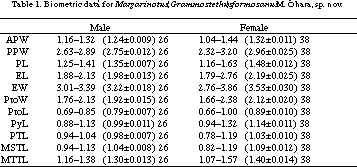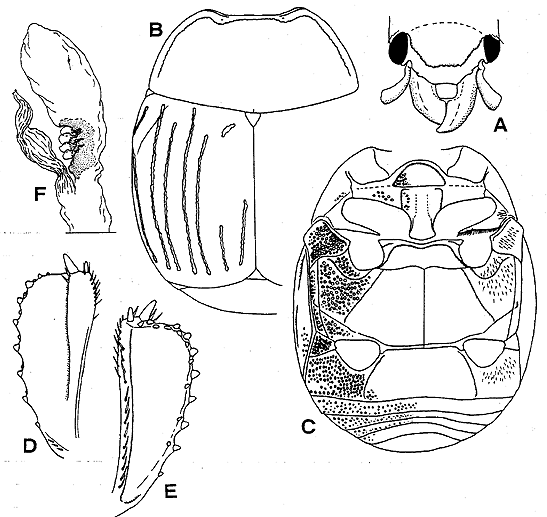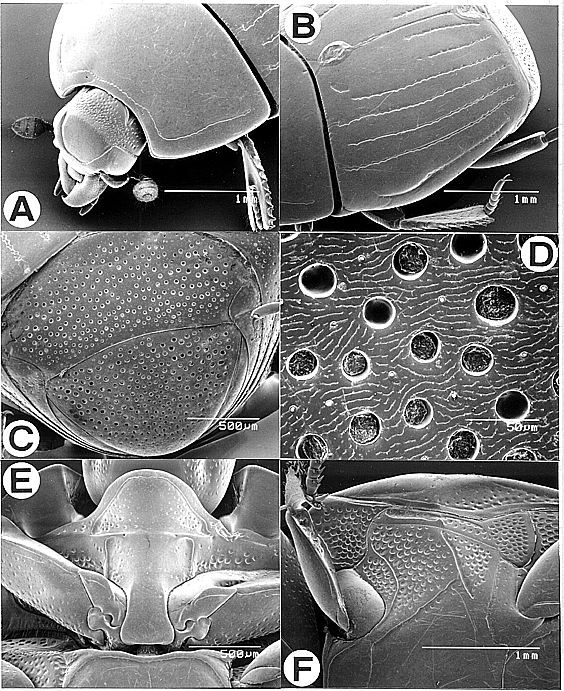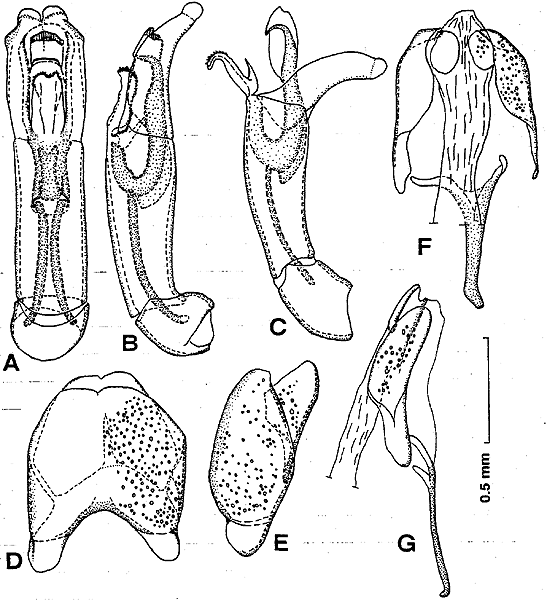Hister (Grammostethus) niponicus: Bickhardt, 1913, 172 [Hoozan]; Miwa, 1931, 57 [Arisan]; Kamiya and Takagi, 1938, 31.
Grammostethus niponicus: Lewis, 1915, 55 [Arisan].
Hister (Grammostethus) niponicus: Bickhardt, 1913, 172 [Hoozan]; Miwa, 1931, 57 [Arisan]; Kamiya and Takagi, 1938, 31.
Grammostethus niponicus: Lewis, 1915, 55 [Arisan].
Type material.
Holotype (SEHU: Laboratory of Systematic Entomology, Faculty of Agriculture, Hokkaidô University, Sapporo, Japan). Male. Point-mounted; genitalia dissected; genitalia in balsam on a plastic slide; labeled: 1. Sonkan (alt. 2,000 m), Nantou prov., 2/iv/1986, M. Ohara; 2. M. Ohara, No-9954; 3. Holo-type, Margarinotus (Grammostethus) formosanus M. Ohara (red label). Paratypes, 118 exs. Taipei Hsien: Chintienkan (2 female, 24/viii/1934), Y.Y. Lien. Taoyuan Hsien: Palin (6 exs., 26/x/1987), J. Luo. Taichung Hsien: Malipulu (1 ex., 28/iv/1986), K. Masumoto. Nantou Hsien: Same data as holotype (68 exs.); (1 male and 1 female, 28/vii/1990), native collector; Nanshanchi (3 exs., 25/iii/1974), K. Masumoto; (3 exs., 13/iv/1986), M. Ohara; Mufu-zhongxin (20 exs., 27/vii/1983), J. Luo; Shiztou, Puli (3 exs., 31/x/1987), J. Luo; (1 ex., 5/xi/1989), native collector; Meifeng (1 ex., 13/v/1973), H. Yokoyama; (1 male and 1 female, 30/vi/1994), C. Luo; Kuantaoshan (1 ex., 9/iv/1990), native collector. Chiai Hsien: Shihou, Alishan (2 exs., 9/iv/1986), M. Ohara. Kaoshiung Hsien: Taoyuang (2 exs., 2/v/1986), M. Ohara; Liukuei (1 female and 1 ex., 16/ix/1988), W.L. Chen.
Description.
Body length, PPL (see page 10, footnote), male, 3.57-5.44 mm,
female, 3.88-4.70 mm. PEL, male, 3.13-4.38 mm, female, 3.38-3.76
mm. Width, male, 3.01-3.39 mm, female, 2.76-3.86 mm. Biometric
data are given in Table 1.  Body
oval, black and shining; antennae, tibiae and tarsi reddish brown.
Body
oval, black and shining; antennae, tibiae and tarsi reddish brown.
Frontal stria of head (Fig. 1A) complete and well impressed. Disk of head sparsely clothed with fine punctures, which are separated by five to seven times their diameter.
Marginal pronotal stria (Fig. 1B) broadly interrupted behind head, complete laterally. Lateral pronotal stria complete, crenate, and its apical portion strongly sinuate behind eyes. Disk of pronotum sparsely clothed with microscopic punctures, and with a longitudinal puncture in antescutellar area.
Epipleura of elytra deeply excavated, and coarsely and sparsely punctate. Marginal epipleural stria deeply and completely impressed. Marginal elytral stria deeply impressed and shortly interrupted at middle. External subhumeral stria well impressed, shortened on basal fourth and apical eighth. Internal subhumeral stria absent. Oblique humeral stria present on basal third. First 4th dorsal striae complete and crenate, 2nd and 4th slightly shortened at base. Fifth dorsal stria usually present on apical third, its basal rudiment represented by a short arc. Sutural stria present on apical half to third. Disk of elytra sparsely clothed with fine punctures.
Pygidia (Fig. 2C) alutaceous. Propygidium with a feebly depression at each side, densely covered with coarse and deep punctures, which are separated by one-third to twice their diameter, and with fine punctures sparsely intermingled with the coarse ones. Pygidium similarly punctate, but a little more densely; area along apical margin without punctures.
Prosternal lobe round at apex, its marginal stria interrupted at middle, well impressed and subcariniform laterally. Disk of lobe coarsely punctate on lateral area. Prosternal keel without carinal stria (sometimes present but rudimentary).
Anterior margin of mesosternum (Fig. 1C, 2E) feebly emarginate at middle, its marginal stria complete and subcariniform, and another short stria present behind each anterior angle. Disk of mesosternum sparsely clothed with fine punctures, which are separated by about ten times their diameter. Meso-metasternal suture complete, subcariniform. Lateral stria of mesosternum (Fig. 2F) extending obliquely and posteriorly, and not united with the oblique stria that extends inwardly form the middle of the metasternal-metepisternal suture. Post-mesocoxal stria extending along the posterior margin of mesocoxa and its outer end attaining to middle of metasternal-mesepimeral suture. Intercoxal disk of metasternum sparsely clothed with fine punctures throughout and a few coarse punctures along the lateral stria. Lateral disk of metasternum densely covered with large punctures on basal half, the punctures becoming sparser on apical half, with fine ones intermingled.
Intercoxal disk of 1st abdominal sternum completely striate on each side, and sparsely clothed with fine punctures.
Protibia (Fig. 1D, E) with 8 large denticles on outer margin. Profemur with posterior marginal stria on apical eighth.
Male genitalia as shown in Fig. 3. Ratio in length of parameres to basal piece about 5.2.
Female genitalia as shown in Fig. 1F. Spermatheca consisting of 4 small sac.
Distribution.
Taiwan.
Remarks.
This species is very similar to M. (G.) niponicus (Lewis) from Japan, but it is distinguished by the following characters: absence of carinal stria of the prosternal keel, the marginal stria of prosternal lobe interrupted at middle, the fine punctation of intercoxal disk of the 1st abdominal sternum, and the structures of the male genitalia. Bickhardt (1913) and Lewis (1915) recorded niponicus from Taiwan. Their records probably refer to this new species. This species belongs to the group of ruficornis in regard of the structures of the male genitalia (Ohara, 1989). It usually occurs in fresh cow dung and sometimes under carrion, while niponicus does not occur in cow dung.

Fig. 1. Margarinotus (Grammostethus) formosanus M. Ohara, n. sp. A: Head, frontal view. B: Pronotum and left elytron. C: Ventral side of adult. D: Left protibia, dorsal view. E: Ditto, ventral view. F: Female genitalia, spermatheca, vagina and bursa copulatrix, lateral view (left side). [AE: no. 9921, Songkang; F: no. 9955, Shihou, Alishan]. (Ohara, 1999).

Fig. 2. Margarinotus (Grammostethus) formosanus M. Ohara, n. sp. A: Head and pronotum, oblique view. B: Left elytron, oblique view. C: Propygidium and pygidium, caudal view. D: Punctation of pygidium. E: Prosternum, ventral view. F: Mesosternum, metasternum and epipleura of elytron, ventral view. [AD: no. 9941, Liukuei, EF: no. 9922, Liukuei]. (Ohara, 1999).

Fig. 3. Margarinotus (Grammostethus) formosanus M. Ohara, n.
sp. Male genitalia. A: Aedeagus, dorsal view. B: Ditto, lateral
view. C: Ditto, median lobe extruded, lateral view. D: Ninth and
10th tergites and 9th sternum (spicule), dorsal view. E: Ditto,
lateral view. F: Eight tergite and sternum, dorsal view. G: Ditto,
lateral view. [A-B, D-G: no. 9922, Liukuei]. (Ohara, 1999).